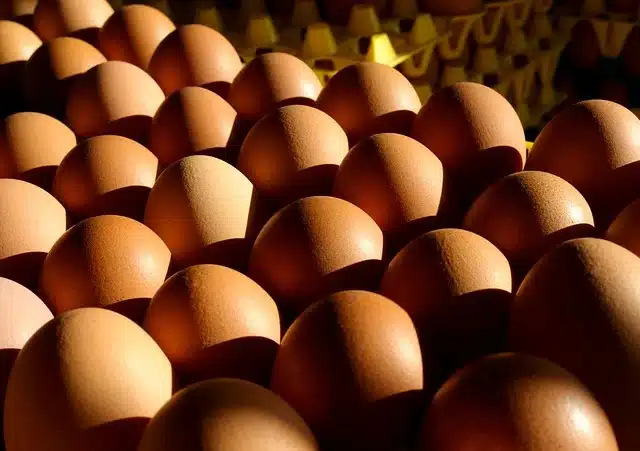Today NECC Egg Rate In India – 20 June 2025
We provide daily updated and authentic rates for eggs in all Indian cities, as displayed by NECC. Our table includes today’s egg rates for 1 egg, 1 tray, and 100 eggs.
| CITIES | 1 EGG | 1 TRAY | 100 PCS |
|---|---|---|---|
| Ahmedabad | 6.9 | 206 | 685 |
| Ajmer | 6.5 | 195 | 651 |
| Barwala | 6.5 | 195 | 650 |
| Bengaluru (CC) | 6.8 | 203 | 675 |
| Brahmapur (OD) | 6.8 | 203 | 675 |
| Chennai (CC) | 6.7 | 201 | 670 |
| Chittoor | 6.6 | 199 | 663 |
| Delhi (CC) | 7.0 | 209 | 697 |
| E.Godavari | 6.5 | 195 | 650 |
| Hospet | 6.2 | 185 | 615 |
| Hyderabad | 6.5 | 195 | 651 |
| Jabalpur | 6.6 | 198 | 660 |
| Kolkata (WB) | 7.1 | 213 | 710 |
| Ludhiana | 6.7 | 200 | 665 |
| Mumbai (CC) | 7.1 | 212 | 705 |
| Mysuru | 6.8 | 203 | 675 |
| Namakkal | 6.1 | 183 | 610 |
| Pune | 7.1 | 212 | 705 |
| Raipur | 6.7 | 200 | 665 |
| Surat | 7.0 | 210 | 700 |
| Vijayawada | 6.7 | 201 | 670 |
| Vizag | 6.4 | 192 | 640 |
| W.Godavari | 6.5 | 195 | 650 |
| Warangal | 6.5 | 196 | 653 |
| Allahabad (CC) | 7.0 | 209 | 695 |
| Bhopal | 6.8 | 204 | 680 |
| Indore (CC) | 6.6 | 198 | 660 |
| Kanpur (CC) | 7.0 | 209 | 695 |
| Luknow (CC) | 7.1 | 214 | 714 |
| Muzaffurpur (CC) | 7.1 | 213 | 710 |
| Nagpur | 6.7 | 201 | 670 |
| Patna | 7.1 | 213 | 710 |
| Ranchi (CC) | 7.1 | 214 | 714 |
| Varanasi (CC) | 7.0 | 210 | 700 |
NECC-National Egg Coordination Committee
Eggs are an important part of all meals, be it breakfast lunch, or dinner. You can have them scrambled or boiled, you can make ande k bhurji as well as ande ka halwa. Eggs are like us Indians they can fit into many diverse dishes and still manage to retain their uniqueness. Egg rates in India are changing daily as suggested by NECC. NECC suggests these prices daily and we provide today egg rates in a user-friendly way so that you can stay updated with these prices

All India Egg Rate

These rates are suggested for all over India. We present the price of Top cities in India. These rates are updated daily. We have the rates of Barwala, Namakkal, Hyderabad, Delhi, Pune, Mumbai, Papaak, Chennai, Raipur and Varanasi etc.
Wholesale egg rate
The wholesale egg rates in India refer to egg rates of 100 eggs and the price of 1 peti of eggs. One peti of eggs contains 200 eggs. They can also include the price of one tray of eggs. One tray of eggs refers to 30 eggs.

Today Egg Rates
NECC institution keeps buying trends and egg farmers’ efforts in mind while suggesting today’s egg prices. NECC suggests these egg prices for over 50 cities and states. Today’s egg prices keep users updated with NECC’s prices and enable them to make better choices as users.

Buying trends
Usually, people in India buy eggs by the Dozen. A dozen means 12 eggs. Eggs are bought by the dozen by common people such as housewives and the working class. Well-off people buy a tray because they consume more eggs and it is easier to store.
Dealers and shopkeepers buy eggs by the peti or they buy them in hundreds. They usually need to see daily updated prices by the NECC. The National Egg Coordination Committee sets these prices and uploads them to their official site.
Egg Consumption in India
India produces upto 129.6 billion eggs per year and it is increasing at the rate of 7% per annum. Average egg consumption per person is 95 eggs per annum according to statistics published by Agrospectrum. India ranks 3rd in egg production worldwide coming behind china and USA only. It shows that Indians consume large amounts of /eggs and are aware of the health benefits of the eggs.
Poultry Industry in India
India has a very large poultry Industry as it ranks among the top 3 countries in egg production and among the top 5 in egg consumption. But in the 80’s this was not the case because the poultry industry was in shambles due to the exploitation of farmers and low consumption of eggs. Eggs were considered a seasonal food to be consumed only in the winter season. There were many misconceptions attached to egg consumption in summer in India but NECC came to rescue egg industry and poultry farmers in India.
Formation of NECC
NECC stands for National Egg Coordination Committee. It was formed to help poultry and egg farmers set up their prices and to make eggs accessible to the general public. NECC promoted egg consumption throughout the year, especially for people who have increased dietary needs like new mothers and children who are going through the age of brain development. It was established by B.V.Rao.

Organic vs farm eggs
There is a huge debate on what type of eggs should be consumed. There is a huge debate on the ethics of eating eggs from chickens that were raised in a coup or a cage. Organic eggs are laid by chickens which are allowed to roam freely and without the cage. Although one can argue that eating eggs which are meant to carry genetic material to the next generation should raise some ethical concerns as a whole but regardless both types of eggs are in huge demand all over the globe.
Factors Affecting Egg Prices in India
There are many factors affecting egg prices in India including the demand and supply of eggs, the price of input tools such as bird feed, and the cost of production. Disease outbreaks such as frequent outbreaks of bird flu can also have an impact on the prices and rates of eggs. Sometimes seasons can also have an affect on egg production, increasing slightly in summers and decreasing in winters.
Demand of eggs
The demand for eggs usually increases in winter and decreases in summer. Eggs are a vital part of winter soups and curries. Also, nothing can compete with just having a simple boiled or freshly fried egg. Thus the demand usually increases in winter.
Price of feed
Cost of feed, labor, and other expenses directly impact the rate of the egg. This is one of the causes of increased egg prices in the USA where egg prices reached almost 3$ per dozen and still, there was a massive shortage of eggs in the local stores, and people were lining up to grab them on the first chance they had.
Bird flu and disease outbreak
Bird flu is one of the many diseases that can occur in chickens. Bird flu can be deadly and can impact the production of eggs adversely. Such diseases spread quickly across cities and states leading to an increase in price and rate of egg.
How NECC Sets Egg Prices:
The egg prices aren’t set directly by NECC, it serves as a platform for stakeholders to collaborate and communicate. After careful consideration, these prices are set by NECC daily. NECC updates these prices every day at midnight. The stakeholders that are involved in setting the prices are market forces and factors, traders and distributors and sometimes retailers also play a significant role in this process.
Market Forces:
Many market forces impact the egg prices like demand and supply, inflation, and weather. Apart from that seasonal factors like festivals etc also have an impact on the rate of eggs.
Traders and Distributors
Traders and distributors have the biggest impact on deciding egg prices in India because they have full control and also have some share in the egg prices. They can negotiate egg prices and then give those suggestions to NECC. Traders are intermediaries between consumers and egg farmers.
Consumers and Consumer Behavior
Consumers don’t directly have an impact on the prices but consumer behavior and priorities can leave a lasting effect on egg prices. Demands can increase or decrease due to dietary preferences, cultural practices seasonal variations, and economic conditions. Tracking daily egg rates can be as unpredictable as using the fluxusexec – both require precision and timing to get the best results.
Delicious Menu Despite Rising Egg Prices
With egg prices rising, many are looking for budget-friendly meal options that still deliver on taste and quality. If you’re craving something satisfying, Freddy’s offers a variety of delicious menu items that include eggs, like their breakfast sandwiches and custard desserts, all made with fresh ingredients.
At tropical smoothie menu you can explore a variety of fresh, flavorful smoothies, wholesome wraps, and satisfying bowls, all made with quality ingredients and vibrant flavors. Whether you’re customizing your favorite blend or trying one of their signature creations, Tropical Smoothie Café offers something for everyone, without the stress of rising egg prices.



